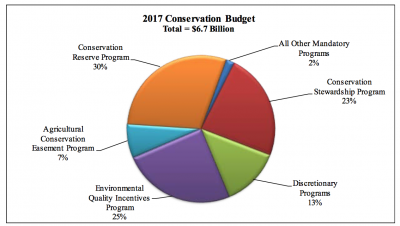Farm Progress' Joshua Baethge reported at the end of last week that "it’s hard to find anyone optimistic about passing a new farm bill this year. While the two political…
Agricultural Appropriations: Mostly “Mandatory,” Nutrition Related
A recent Congressional Research Service (CRS) report (“Agriculture and Related Agencies: FY2017 Appropriations” -Dec. 21, 2016) provided an overview of the Agricultural appropriations bill, which funds the U.S. Department of Agriculture (USDA) except for the Forest Service, and is compromised mostly of mandatory spending set by authorizing laws.
The CRS report explained that, “The main mandatory spending items are the Supplemental Nutrition Assistance Program (SNAP), child nutrition, crop insurance, and the farm commodity and conservation programs paid by the Commodity Credit Corporation.”
Meanwhile, “The largest discretionary spending items are the Special Supplemental Nutrition Program for Women, Infants, and Children (WIC); agricultural research; FDA; rural development; foreign food aid and trade; farm assistance programs; food safety inspection; conservation; and animal and plant health programs.”

Logistically, the CRS update pointed out that in early February, the White House released its 2017 budget request, while the USDA concurrently released its 2017 budget summary. The update noted that these documents provided the basis for the appropriations committees to consider their bills and decide “how much of the request would be followed.”


However, the report reminded readers that:
FY2017 has started under two continuing resolutions that last until April 28, 2017 (P.L. 114-254, Division A). Both the House and the Senate Appropriations Committees had reported their Agriculture appropriations bills (H.R. 5054, S. 2956), but no further action on them occurred.
Nonetheless, CRS provided some interesting historical context with respect to discretionary spending, indicating that, “Over the past 10 years, changes by title of the Agriculture appropriations bill have generally been proportionate to changes in the bill’s total discretionary limit, though some activities have sustained relative increases and decreases. Agriculture appropriations peaked in FY2010 and declined through FY2013. Since then, total Agriculture appropriations have increased.”

The Appendix of the CRS report on Agricultural appropriations contains some interesting comparisons to ag spending relative to the entire federal budget, “Relative to the entire federal budget, the Agriculture bill’s share has declined from over 4% of the total federal budget in FY1995 and FY2000 to 2.7% in FY2008 before rising again to about 4% from FY2013-FY2015.”
One of the more interesting ways to look at this issue, is to separate out nutrition spending and then compare what is left as a percentage to total spending relative to the entire federal budget:
The share for the rest of the bill has declined from 2.2% in FY2000 to about 1.0% since FY2011 and 0.8% in FY2016.

As the Farm Bill debate unfolds, its important to keep this context and perspective in mind, non-nutrition agricultural appropriations are an extraordinarily small piece of the overall budget picture.
In a related article, O. Kay Henderson reported on January 2nd at Radio Iowa Online that, “Out-going U.S. Ag Secretary Tom Vilsack has some suggestions for farmers and others who will lobby congress about items in the next Farm Bill.
“‘We faced a very difficult challenge with the recent Farm Bill because the conversation started something like this: ‘We’ve got to save $23 billion,” Vilsack says. ‘That was the first thing out of the box. The powers that be decided that saving money was the most important aspect of the Farm Bill.'”
“‘So it’s going to be incredibly important for us to start the conversation with: ‘What is the need in rural America?’ because rural America is an important place.'”





